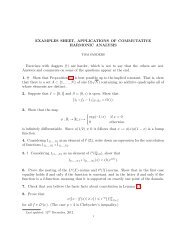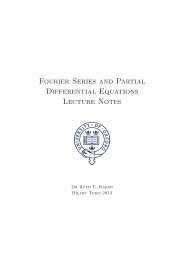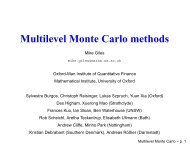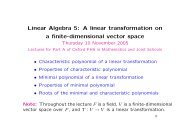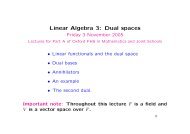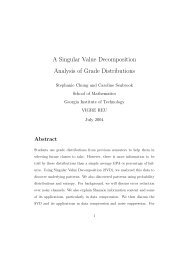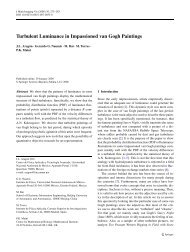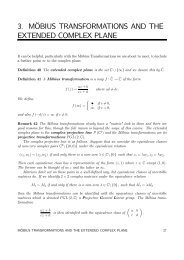Construction of Hyperkähler Metrics for Complex Adjoint Orbits
Construction of Hyperkähler Metrics for Complex Adjoint Orbits
Construction of Hyperkähler Metrics for Complex Adjoint Orbits
Create successful ePaper yourself
Turn your PDF publications into a flip-book with our unique Google optimized e-Paper software.
3.3 Regular Nahm Solutions and Line bundles on S 40<br />
For j = 0, 1, 2, 3, we denote the restriction <strong>of</strong> σj to Ci ∩ U0 by fji. As in<br />
(3.15) and (3.16), we may write<br />
fji = exp( k−1<br />
j=1 (λi) j q +<br />
j (ζ)) exp(λis) ( k−1<br />
l=0 cj<br />
i,l ζl ), (3.31)<br />
˜fji = exp(− k−1<br />
j=1 (λi) j q −<br />
j (˜ ζ)) ( k−1<br />
l=0 cj<br />
i,l ˜ ζ k−1−l ). (3.32)<br />
The relation (3.30) on Ci ∩ U0 may be written as<br />
λiζf01 + f1i + ζf2i + ζ 2 f3i = 0, (3.33)<br />
<strong>for</strong> i = 1, . . . , k; we have similar relations <strong>for</strong> the restrictions to Ci ∩ U∞. In<br />
order to obtain the endomorphism Ãj−1(s), <strong>for</strong> j = 1, 2, 3, which is defined<br />
by the equation Ãj−1(s)σ0 = σj, we have to solve <strong>for</strong> the c j<br />
i,l ′ s in terms <strong>of</strong> the<br />
c 0 i,l ′ s. It is clear from the discussion in the previous paragraph and from the<br />
relations (3.33) that we may choose a basis <strong>of</strong> H 0 (S; ML s (k−1)) with respect<br />
to which the matrix [ Ãj−1(s)] has coefficients which are rational functions <strong>of</strong><br />
e λ1s , . . . , e λks . We shall come back to this is the discussion <strong>of</strong> the Kähler<br />
potential later on.<br />
3.3.4 The Theta Divisor Condition<br />
We now consider the condition<br />
H 0 (S, ML s (k − 2)) = 0 <strong>for</strong> all s ∈ (−∞, 0], (3.34)<br />
<strong>for</strong> a line bundle M <strong>of</strong> degree 0 on the spectral curve S. In general, this is<br />
a difficult condition to verify, as observed in [Hit83]. On the other hand, in<br />
our situation the simple expression <strong>of</strong> the spectral curve allows us to obtain<br />
an explicit description <strong>of</strong> the theta divisor, which in turn shows that the<br />
condition (3.34) is not very restrictive: if a line bundle M does not satisfy<br />
this condition, one may translate it by a line bundle <strong>of</strong> the <strong>for</strong>m L a in order<br />
<strong>for</strong> (3.34) to hold.




